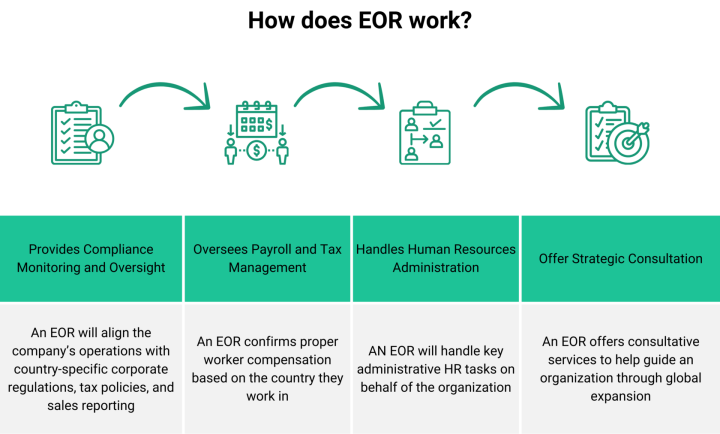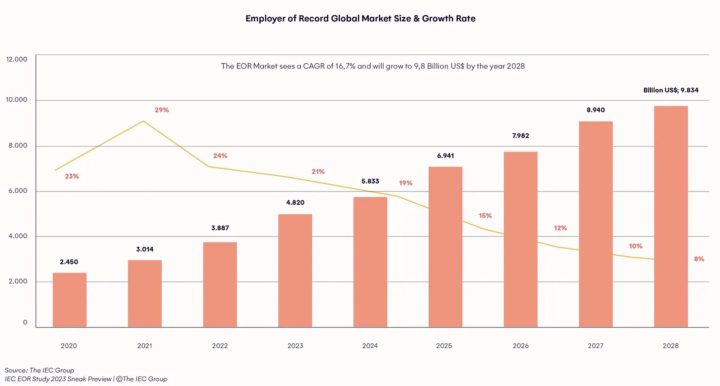As any business entity expands, business owners start thinking of hiring new staff and growing in scale. In these conditions, it’s normal to take advantage of the universally accessible global pool of talent. The choice is definitely broader on a global scale, and international hiring also solves the problem of high rates charged by local specialists.
Yet, compliance and red tape may come in the way in the process of hiring staff in jurisdictions other than your business’s legal presence. This is where the Employer of Record (EOR) comes to the rescue, offering compliant hiring across the globe. EOR service providers help businesses handle legal responsibilities towards employees under local labor laws in various countries, manage taxes, execute payroll and social benefits coverage, and oversee routine HR processes.
With business getting more global in all parts of the world, the EOR industry is also growing to enable companies to concentrate on core business processes. The EOR market is estimated to reach a $1.7 billion mark by 2028, which means it grows at a CAGR of 12%+.
Are you interested in growing your workforce without bringing all the new staff on your payroll? This article presents a detailed discussion of the EOR model and its meaning, the benefits of employing EOR for your staff expansion, and a step-by-step guide to choosing the best EOR partner for your business activities.
Defining Employer of Record (EOR)
Many are wondering, “What is an employer of record?” let’s start with the definition. In a nutshell, an EOR provider is a third party that stands between the employee and the actual employer by serving as the person’s (or vendor’s) official employer. Due to the EOR’s legal presence in many countries, these companies can ensure the hiring of people who are legally compliant in countries where the client has no legal presence. This way, the EOR manages all administrative duties and work permits on a local basis while the employee starts performing their duties right away.
Though the EOR model is new for many, the truth is that it’s been here since the 1960s. The concept emerged in the USA over six decades ago because of the deepening recruitment problems experienced by businesses. Employee leasing arrangements appeared in the 1970s, marking the new era of HR outsourcing. The trend grew in scale in the 1990s, but things accelerated with the rapid spread of the Internet, making the global labor market borderless. The COVID-19 pandemic also contributed to EOR’s growing popularity because of the massive shift towards remote work and digitalization. Therefore, EOR is the new normal in the field of hiring, with hundreds of companies using EOR services to access global talent without legal and administrative hassle.
It is important to differentiate between the EOR model we’ve just discussed and other related models for hiring, such as Agent of Record (AOR) and Professional Employer Organization (PEO).
- While EORs deal with individual contractors, AORs handle vendor hiring . Thus, you may hire people with the help of EOR and deal with agencies via an AOR.
- PEOs are companies that hire staff full-time and then ‘lease’ it to clients. This way, a PEO resembles a traditional outsourcing or outstaffing model much more. Due to this arrangement, the PEO also bears a part of the responsibility for employee taxes, social benefits, and administration.
| Aspect | AOR | EOR | PEO |
|---|---|---|---|
| Legal Responsibilities | Limited | Assumes full employer legal responsibilities | Shared legal responsibilities |
| Tax Responsibilities | Responsible for 1099 processing | Handles all employee tax withholdings and reporting | Co-manages employee tax withholdings and reporting with client |
| Administrative Responsibilities | Handles contractors payments and related administrative tasks | Manages HR, payroll and compliance | Co-manages HR, Payroll and compliance with client |
| Management of Workers | Minimal, primarily facilitates payment | Direct employer, involved in day-to-day management | Shared management responsibilities |
| Provision of Benefits | Not responsible | Provides employee benefits | Co-provides employee benefits with client |
How Does EOR Work?
As we’ve already clarified, an EOR provider assumes responsibility for a wide range of employment tasks while the company maintains full operational control over the hired staff. As a rule, EORs process payroll to all international employees, withhold taxes from the staff’s salaries, administer social benefits, and continually monitor compliance with local labor laws.
Clients sign a contract with EOR providers, where they indicate the full range of services they want to delegate. The contract should specify the number of required employees, their duties in line with a job description, and the preferred length of employment. Once the contract is negotiated and signed, the EOR locates and hires the needed staff, onboarding new employees to the client’s work system. Since the EOR is all new workers’ official employer, this company handles all obligations under labor law, such as paid leave, payroll, taxation, and health insurance. At the same time, the hiring company (EOR’s client) controls the employees’ daily activities, assigns work tasks to them, and manages their performance.

Functions of an EOR provider
Key Services Provided by EOR
Here are the main aspects for which an EOR provider usually assumes responsibility.
- Compliance with local laws
The main business risk of international hiring is compliance with local labor regulations and taxation. It is hard to manage these issues in multiple jurisdictions where a company may have only a handful of employees. An EOR handles all legal aspects of employment instead of the client, thus guaranteeing the absence of legal risks. - New staff onboarding
The EOR provider handles new staff employment and welcomes the hired contractors to the client’s ecosystem. In some cases, a client company uses the EOR’s talent management platform to connect with remote employees and streamline their work. - International payroll operations
Payroll, tax deductions, social benefits, health insurance, and all other kinds of compensation lie on the EOR’s shoulders because this company is the staff’s legal employer. The client company covers all those expenses based on the pre-negotiated contractual agreement. - End-to-end contract management
Since the EOR employs new staff, it handles the full contract lifecycle, from a job offer and signing a contract to its termination. - Consulting services
EOR providers have a solid understanding of the international hiring market, so they can consult a client company on the best hiring practices, optimal jurisdictions, and other arrangements suiting the business’s needs and budget.
Benefits of Using an EOR
While the usage of EOR services may seem to be a redundant and costly extra chain in the hiring process, there are many benefits of EOR. These are the most pronounced advantages you’re sure to get when organizing international hiring following the EOR model.
- Flexibility and Convenience
It takes time, money, and nerves to enter new labor markets. In many situations, the game isn’t worth the candle. That’s why it makes sense to test new markets safely and flexibly via the EOR service. This way, you will access talent in many jurisdictions without going through an expensive and lengthy process of establishing a legal entity there.Besides, an EOR is usually experienced in working with local employees. So, it will help you avoid common blunders and mishaps new businesses often experience when entering totally alien markets. - Cost-Effectiveness
Establishing a legal presence in a new jurisdiction is quite expensive. Not every business can afford the cost of building legal entities in every target market, while freelancing may also be not an option. That’s when EOR providers come in handy. These services are specifically relevant to SMEs and startups on a budget, which need new staff but can’t bear the costs of handling those legal procedures. - Risk Aversion
Businesses may face unexpected liabilities when hiring people internationally. That’s why you should either set up a separate HR department with international expertise or use the services of experienced EORs to ensure your hiring is risk-free and legally compliant. If you work with an EOR, you may rest assured they will take care of taxation, payroll, and benefit management on their part, while you only maintain a productive working partnership with the hired employee.
Choosing the Right EOR Partner
As the international hiring market continues to grow exponentially, so does the versatility of EOR services provided across the globe. Thus, it may be hard to choose a credible and trustworthy EOR partner for your business. Which criteria should you prioritize when selecting an EOR company?
We’ve singled out the following core parameters:
- Technology fit. Most EORs have technology platforms where clients can access all payroll, taxation, and HR management data about their employees. This software unifies all stakeholders and simplifies data sharing, storage, and reporting. Thus, you need to check whether the EOR’s software integrates smoothly into your existing software architecture, or it will cause additional administrative hassle.
- Service Level Agreement (SLA). An SLA is the main document that may enable you to hold the EOR liable for substandard service. That’s why you should ensure the SLA is written precisely and contains concrete terms that fix the EOR’s scope of responsibility.
- Pricing model. The cost and pricing structure of EOR services may often look overwhelming and complex. Some EORs charge a fixed sum per employee, while others charge a specified percentage of the employee’s salary. That’s why you should understand the pricing model inside out before signing the contract; it’s the only way to avoid unpleasant hidden costs and extra charges.
- Quality of communication. You should be sure that the EOR provides a dedicated manager for continuous communication on all aspects, timely support, and transparency in all operations.
- Contractual terms. It is vital to study all contract conditions between you and the EOR, focusing on confidentiality, IP rights, data privacy, and contract termination (with employees and the EOR). A reliable partner should have robust data privacy and cybersecurity measures in place to avoid critical business risks for you.
You may also add some more points to the list, depending on your specific niche of business operations, individual requirements for staff, budget, and deadlines.
Case Studies/ Success Stories
Many companies have already tried EOR services to grow or handle temporary business issues with international hiring. Here are a couple of real-world case studies of how EOR works:
- A distinguished interactive agency based in Chicago, BBG, partnered with GEOR to hire top talent aligning with their business objectives and augmenting their workforce to manage ongoing projects. They managed to onboard 15+ new employees with a relevant skillset from 3 countries within one year of collaboration.
- Apple has been using the EOR service of Marcom Talent Network for many years, sourcing staff from multiple jurisdictions and attaining a global presence.
- MediaMath’s need for specialized AdTech expertise and desire for increased operational flexibility led them to GEOR and the staff augmentation model. This model provided a seamless extension to their in-house team. It allowed them to dynamically scale resources to meet project demands.
- Based in the US, Rubicon Project is at the forefront of the AdTech industry. To support its IT projects, the company turned to GEOR to hire an dedicated team of software engineers.
EOR is evolving and we will soon see new trends in employment. Therefore, GEOR monitors the current situation and introduces new services according to the market needs.
The Future of EOR
The modern workplace is truly global, and the issue of access to the workforce is a top priority for international businesses. That’s why the EOR industry is poised to grow, with the present-day rise of the gig economy, the increasing complexity of local labor laws, and the increasing pressure for business agility and quick adaptation.

Employer of record global market size and growth rate
For all these reasons, we can expect the EOR market to continue growing at a fast pace, meeting business needs for compliant hiring and addressing employees’ desire for flexibility and mobility. Many businesses in Europe and North America are adopting remote and hybrid work styles, partly because of the impact of COVID-19 and partly in response to the rising costs of the domestic workforce.
Yet, to meet the growing demand for EOR services, providers need to overcome several challenges, such as:
- Finding top talent matched with the client’s job description across jurisdictions.
- Exploring viable alternatives for operational cost reduction.
- Consolidating HR services on a single service platform for customer satisfaction.
These are the pivotal growth obstacles that undermine the credibility of EOR providers. So, once they are effectively addressed, the EORs can occupy a solid niche in the international hiring market and enjoy long-term prospects.
Final Word
As the pace of globalization increases, businesses have an unprecedented advantage of global access to talent. However, this access comes with new challenges in terms of local legal compliance and employment management across jurisdictions. Therefore, EOR services offer a unique opportunity to embrace the benefits of global hiring while offsetting its risks at an affordable cost. By using EOR services, businesses can focus on the employees’ tech stack instead of geography. That’s why the EOR model offers a viable and flexible business solution in the complicated and dynamically changing international business environment.




